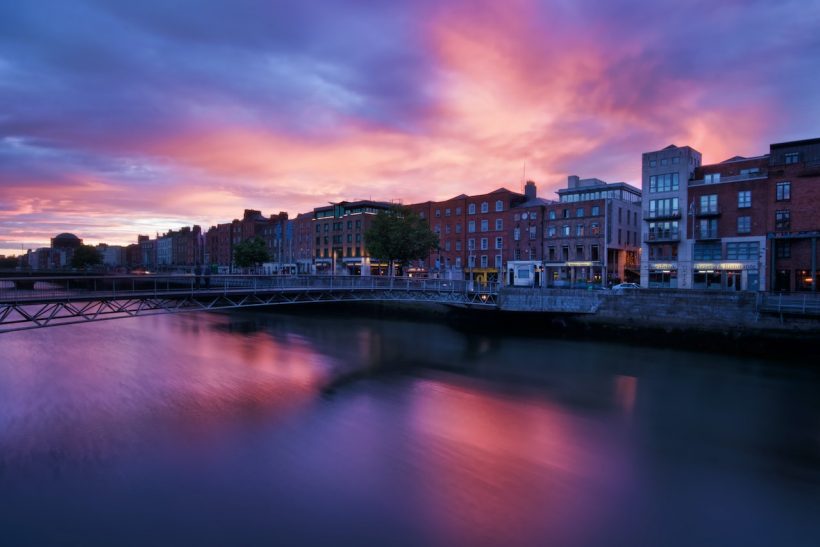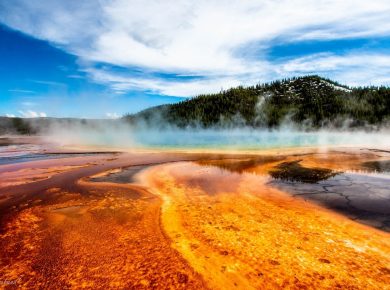Ireland is lovingly referred to as The Emerald Island thanks to its ample greenery found in every direction. Every county has its unique charm as farmsteads, rolling hills, and parks dot the countryside. Those feeling more adventurous often make their way to the west coast’s Cliffs of Moher, offering breathtaking views that drop off over the Atlantic Ocean.
But can you simply fly to Ireland and comfortably take in these sights any time of the year? Luckily, the country lacks severe weather and temperatures that would bar travel at certain times in other countries. If you can stand a bit of rain, it’s only a matter of picking the tourist season you feel most comfortable in.
Summertime means pleasantly warm weather and extra sunlight, but big crowds. On the other hand, a winter vacation here offers smaller groups and a quieter atmosphere. Expect cold but bearable temperatures and early sunsets that turn into long nights as black as a pint of Guinness.
What comes to mind when you read the name “Ireland?” Among many things, one of them is probably seas of shamrocks. If you want your vacation views to be this lush and green, booking at the right time of year is crucial!
This article assesses the average weather and tourist season trends to determine the best month to visit Ireland for good weather and low prices. To do this, we will look at three cities spread around the country: Dublin on the east coast, Sligo up north, and Shannon on the west coast.
Table of Contents
Average Temperature In Ireland
Ireland’s location as an island in the North Atlantic gives it a short range of temperatures more similar to the United Kingdom than Western Europe. Bringing a coat is a wise choice at any time of year. The question is how heavy the coat should be.
Shannon gets the warmest summer temperatures, peaking in July with an average high of 67°F and a cool low of 55°F. Dublin is a very close second at 66°F and 54°F, while Sligo is a bit cooler at 63°F and 54°F.
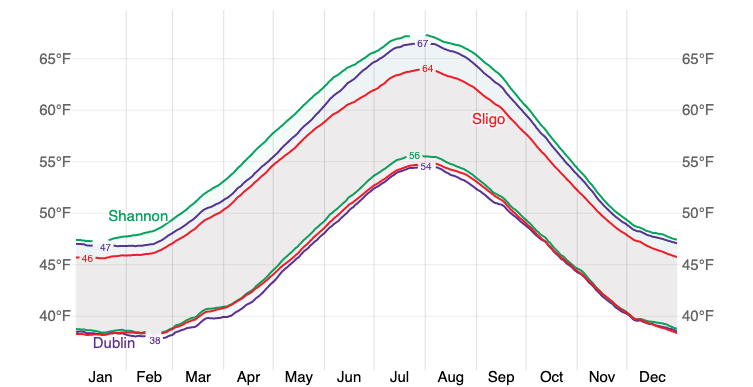
This trend continues throughout the year, with Shannon slightly warmer than Dublin and Sligo just behind. The average low temperatures differ less, so there is usually only a 2°F difference between Shannon and Sligo at night.
Winter brings cold temperatures to all of Ireland, but the Irish don’t freeze! Each city’s temperature stays in the upper 40s during the day and drops to the upper 30s at night. If you don’t mind bundling up, sightseeing in Ireland will be no problem for you.
Spring sees a gradual thaw in the three cities, with Shannon warming up the fastest. It hits 60°F by May while the other two stay in the upper 50s. Fall, on the other hand, brings a gradual cooling off.
Daily Chance Of Precipitation In Ireland
Pretty green pastures don’t come without the occasional gloomy, rainy day. Ireland has plenty of these year-round, so add rain gear to your packing list.
Sligo is consistently the rainiest throughout the year, Dublin is the “driest” (though hardly dry), and Shannon is the median.
The country’s drier season starts in May and goes until mid-July. In this period, expect about a 30-35% chance of precipitation in Sligo, about 29% in Shannon, and about 26% in Dublin.
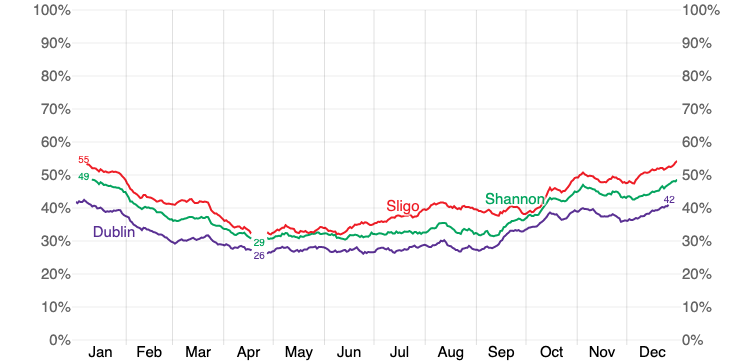
Rainy weather picks up again from mid-July and stays that way until the following spring! There are varying levels, though. Late summer through early fall sees the precipitation chance jump to over 40% for Sligo, the mid-30s for Shannon, and about 28% for Dublin. Then, from mid-September, the chances of precipitation jump and keep growing until mid-January!
You’ll encounter the rainiest weather in Ireland if visiting in late autumn, winter, or early spring. Mid-January’s peak sees a 55% precipitation chance in Sligo, 49% in Shannon, and 42% in Dublin. And since the temperature rarely drops below freezing, count on this precipitation to come in the form of cold, crisp rain, up to 4.1 inches a month.
Humidity Comfort Levels In Ireland
If swampy, muggy weather bothers you, you’ll be delighted to discover that Ireland has almost none of it! Humidity is an anomaly to the Irish, who get an average of zero humid days nearly all year.
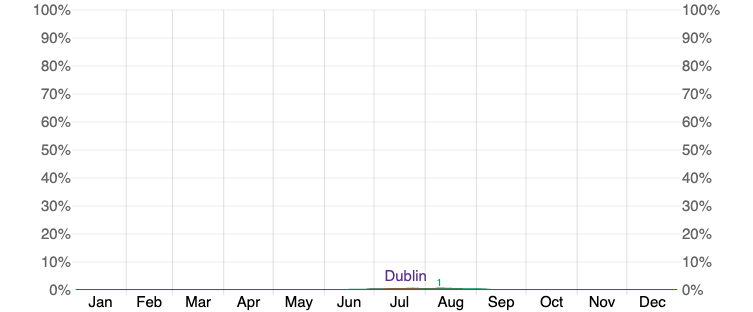
The only place with the possibility of such weather is Shannon, which gets a whopping 0.1 humid days in July and August. However, this number is relatively insignificant, and you can instead focus on booking to avoid heavy rain. The 0.1 should not deter you from a summer visit to Ireland’s west coast.
Best Time Of Year To Visit Ireland For Great Weather
Ireland’s unique weather patterns are both a blessing and a curse. While you should expect neither humidity nor blistering heat, you will encounter some rain and uncomfortably chilly temperatures.
When is the best time to visit to keep as warm and dry as possible? It’s challenging but not impossible! Occasional rain showers are always on the horizon, but some months get more clear days than others.
Two factors are used to decide the best months for weather: the “tourist score” and the “beach/pool score,” respectively. The first is used to determine how pleasurable outdoor activities like sightseeing tours are in a given month. Clear skies and temperatures between 65°F and 80°F are the criteria here.
Ireland’s tourist score indicates that the three cities are best visited in mid-July. They all share a similar curve on the chart, with Sligo slightly lower on the scale due to its slightly rainier and colder weather. Dublin and Shannon scored 6.1/10, meaning that at their best, their weather conditions are still tricky for city walks.
The country ranks poorly on the beach/pool score, with Shannon being the high scorer of 1.1/10 in July. If you’d like to go for a swim, you might book a hotel with an indoor pool. Dips in the sea or lake are more suited for the extreme.
Even at its peak, Ireland’s tourist score is significantly lower than other European countries. However, don’t let that stop you from visiting. Being mindful of rainfall and temperatures will help you prepare for a magical time in The Land of Saints and Scholars.
Best Time Of Year To Visit Ireland For Low Prices
Ireland isn’t famous for being a budget traveler’s paradise, but finding deals is still possible.
Flight deals are straightforward to find. Are you coming from nearby? Ryanair, the leader of budget airlines, is an Irish company. Cheap connections from other European cities, large and small, make Ireland an easy addition to a multi-city trip. Though Ryanair doesn’t connect from the USA, several carriers make long-haul flights to Dublin, a major trans-Atlantic hub airport.
September, October, and the spring months are typically the cheapest windows for flight booking to Ireland. February is also among the most affordable, but the dreary, rainy winter weather deters most.
However, if you don’t mind visiting in the dark, wet winter months, you’ll save the most on accommodation! Many of them shut down for the winter season, but the ones that stay open have slashed prices.
Traveling in the fall and spring is also less costly than in summer. Hotels cost more than in winter, but you’ll pay less than the tourists who flock to Dublin in July. If you want to avoid paying premium prices on hotels and flights, there are two other times of year to avoid: Christmas and St. Patrick’s Day.
Ireland hosts holiday markets and other related events that families visit. The latter holiday needs no explanation. The Irish celebrate it. Foreign tourists come in droves to help them celebrate it. Expect massive crowds, as it’s a national holiday and not a mini-celebration as it often is in the USA.
When Should You Go To Ireland?
Peak Travel Season In Ireland
Are you spending your summer vacation in Ireland? You’ll get the best weather all year and enormous hordes of tourists. July and August are the official peak months for Irish tourism. Tourist attractions are sure to be packed, and locals will also take advantage of warm temperatures and extra sunlight (up to 17 hours daily in July).
If big crowds aren’t for you, don’t let that deter you from visiting. Relaxing in a quaint, provincial B&B is a huge draw in the summer. Many of them close for the colder, darker months leaving only the summer to take in the Irish countryside.
Tourist numbers peak again around St. Patrick’s Day. Cities tend to be the most crowded, with shoulder-to-shoulder seas of people in central Dublin near its iconic Temple Bar. If you’d like to experience an authentic St. Paddy’s celebration, consider visiting a smaller town where fewer tourists think to stay.
It’s no less Irish but much less busy! Expect flight and accommodation prices to be at an all-time high for summer and St. Patrick’s Day. You have to pay this price if you want the best weather possible for your Irish vacation.
Shoulder Travel Season In Ireland
Unable to make it to Ireland in March? No problem! The Irish have much more to celebrate than St. Patrick’s Day, and the shoulder season is full of events, decent weather, and reasonable prices.
The season is split in two, from April through early June and again in October. The weather, though less desirable than the island’s balmy summer, is still bearable. It bears mentioning again: prepare for rain! It’s inevitable when visiting at any point of the year. Even summer isn’t perfect.
Early June, the tail end of shoulder season, has excellent conditions for travel (comparatively, of course- This is Irish weather we’re talking about). The daily precipitation rates are still low like the other spring and summer months, and the temperature climbs to the mid-60s in the daytime.
The weather is almost like July and August, and the crowds have yet to show up. Plus, the days get longer throughout the month, so enjoy more daylight to enjoy attractions and pub patios.
Traveling in this window just outside peak season may also help you secure a good flight and hotel rate. Everything will be open in preparation for the peak season, and you’re bound to strike a pot of golden deals if you act quickly.
Low Travel Season In Ireland
Every travel guide warns of the dreary, nightmarish off-season that takes hold in November and lingers around until mid-spring. The days are cold and short. You will get rained on. But should it be avoided altogether?
Ireland’s beauty and charm don’t end when the winter kicks in. Sure, the wet and cold combination makes rural attractions a challenge. They’re best left to another season.
Many countryside accommodations close their doors for the season, but a few still welcome guests. The conditions can provide the perfect intimate, reflective retreat that some may desire from a vacation.
The cities, however, are perfect for sightseeing and walking around. Fewer tourists mean less congestion in city centers and at famous attractions. They still operate, some with shortened hours.
It’s best to research operating hours if visiting in the off-season. Locals seek refuge from the cold rain in cozy pubs where the atmosphere is warm, and the service is friendly.
Flights and hotels are at their all-time cheapest in January and February. A winter visit equals significant savings. Winter in Ireland isn’t all sadness and misery, as many claim. It has a unique atmosphere that summer visitors miss. Besides, what’s to be sad about when you save on booking your trip?
Best Months For Travel To Ireland
Each of Ireland’s seasons has boundless opportunities for visitors to have unforgettable fun. The best time to visit depends largely on your travel type. If a quiet, relaxing getaway is more important than seeing all the attractions, don’t write off a winter visit as the travel guides do. Though the weather may not be the friendliest, the prices are!
For most activities, people want warm temperatures and clear skies. This makes June one of the best times to visit Ireland. The days are almost as warm and bright as July and August sans peak season madness. In addition, you’re highly likely to nab a good price for your flight and hotel just before they ramp up for the summer.
Rain is inevitable, but no season is safe from at least a slight drizzle. All the country’s attractions are open at this time, so you can experience almost everything that makes The Emerald Island unique.
